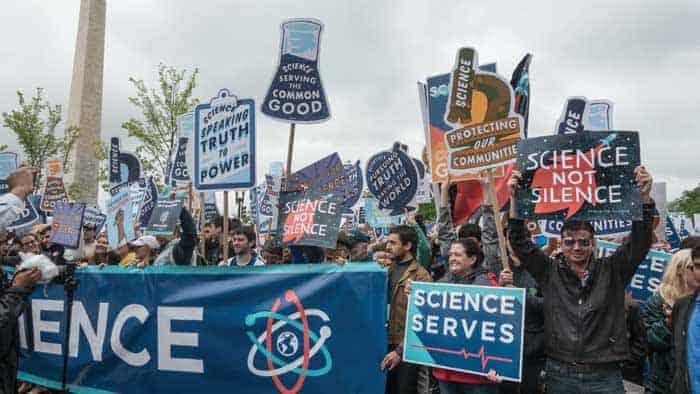Donald Trump’s second term as US president has begun with staff layoffs, slashed budgets, axed diversity programmes and cancelled conferences. Peter Gwynne examines the damage

Scientists across the US have been left reeling after a spate of executive orders from US President Donald Trump has led to research funding being slashed, staff being told to quit and key programmes being withdrawn. In response to the orders, government departments and external organizations have axed diversity, equity and inclusion (DEI) programmes, scrubbed mentions of climate change from websites, and paused research grants pending tests for compliance with the new administration’s goals.
Since taking up office on 20 January, Trump has signed dozens of executive orders. One ordered the closure of the US Agency for International Development, which has supported medical and other missions worldwide for more than six decades. The administration said it was withdrawing almost all of the agency’s funds and wanted to sack its entire workforce. A federal judge has temporarily blocked the plans, saying they may violate the US’s constitution, which reserves decisions on funding to Congress.
Individual science agencies are under threat too. Politico reported that the Trump administration has asked the National Science Foundation (NSF), which funds much US basic and applied research, to lay off between a quarter and a half of its staff in the next two months. Another report suggests there are plans to cut the agency’s annual budget from roughly $9bn to $3bn. Meanwhile, former officials of the National Oceanic and Atmospheric Administration (NOAA) told CBS News that half its staff could be sacked and its budget slashed by 30%.
Even before they had learnt of plans to cut its staff and budget, officials at the NSF were starting to examine details of thousands of grants it had awarded for references to DEI, climate change and other topics that Trump does not like. The swiftness of the announcements has caused chaos, with recipients of grants suddenly finding themselves unable to access the NSF’s award cash management service, which holds grantees’ funds, including their salaries.
NSF bosses have taken some steps to reassure grantees. “Our top priority is resuming our funding actions and services to the research community and our stakeholders,” NSF spokesperson Mike England told Physics World in late January. In what is a highly fluid situation, there was some respite on 2 February when the NSF announced that access had been restored with the system able to accept payment requests.
“Un-American” actions
Trump’s anti-DEI orders have caused shockwaves throughout US science. According to 404 Media, NASA staff were told on 22 January to “drop everything” to remove mentions of DEI, Indigenous people, environmental justice and women in leadership, from public websites. Another victim has been NASA’s Here to Observe programme, which links undergraduates from under-represented groups with scientists who oversee NASA’s missions. Science reported that contracts for half the scientists involved in the programme had been cancelled by the end of January.
It is still unclear, however, what impact the Trump administration’s DEI rules will have on the make-up of NASA’s astronaut corps. Since choosing its first female astronaut in 1978, NASA has sought to make the corps more representative of US demographics. How exactly the agency should move forward will fall to Jared Isaacman, the space entrepreneur and commercial astronaut who has been nominated as NASA’s next administrator.

Scientists braced for Donald Trump’s second term as US president
Anti-DEI initiatives have hit individual research labs too. Physics World understands that Fermilab – the US’s premier particle-physics lab – suspended its DEI office and its women in engineering group in January. Meanwhile, the Fermilab LBGTQ+ group, called Spectrum, was ordered to cease all activities and its mailing list deleted. Even the rainbow “Pride” flag was removed from the lab’s iconic Wilson Hall.
Some US learned societies, despite being formally unaffiliated with the government, have also responded to pressure from the new administration. The American Geophysical Union (AGU) removed the word “diversity” from its diversity and inclusion page, although it backtracked after criticism of the move.
There was also some confusion that the American Chemical Society had removed its webpage on diversity and inclusion, but they had in fact published a new page and failed to put a redirect in place. “Inclusion and Belonging is a core value of the American Chemical Society, and we remain committed to creating environments where people from diverse backgrounds, cultures, perspectives and experiences thrive,” a spokesperson told Physics World. “We know the broken link caused confusion and some alarm, and we apologize.”
For the time being, the American Physical Society’s page on inclusion remains live, as does that of the American Institute of Physics.
Dismantling all federal DEI programmes and related activities will damage lives and careers of millions of American women and men
Neal Lane, Rice University
Such a response – which some opponents denounce as going beyond what is legally required for fear of repercussions if no action is taken – has left it up to individual leaders to underline the importance of diversity in science. Neal Lane, a former science adviser to President Clinton, told Physics World that “dismantling all federal DEI programmes and related activities will damage lives and careers of millions of American women and men, including scientists, engineers, technical workers – essentially everyone who contributes to advancing America’s global leadership in science and technology”.
Lane, who is now a science and technology policy fellow at Rice University in Texas, think that the new administration’s anti-DEI actions “will weaken the US” and believes they should be considered “un-American”. “The purpose of DEI policies programmes and activities is to ensure all Americans have the opportunity to participate and the country is able to benefit from their participation,” he says.
One senior physicist at a US university, who wishes to remain anonymous, told Physics World that those behind the executive orders are relying on institutions and individuals to “comply in advance” with what they perceive to be the spirit of the orders. “They are relying on people to ignore the fine print, which says that executive orders can’t and don’t overwrite existing law. But it is up to scientists to do the reading — and to follow our consciences. More than universities are on the line: the lives of our students and colleagues are on the line.”
Education turmoil
Another target of the Trump administration is the US Department of Education, which was set up in 1978 to oversee everything from pre-school to postgraduate education. It has already put dozens of its civil servants on leave, ostensibly because their work involves DEI issues. Meanwhile, the withholding of funds has led to the cancellation of scientific meetings, mostly focusing on medicine and life sciences, that were scheduled in the US for late January and early February.
Colleges and universities in the US have also reacted to Trump’s anti-DEI executive order. Academic divisions at Harvard University and the Massachusetts Institute of Technology, for example, have already indicated that they will no longer require applicants for jobs to indicate how they plan to advance the goals of DEI. Northeastern University in Boston has removed the words “diversity” and “inclusion” from a section of its website.
Not all academic organizations have fallen into line, however. Danielle Holly, president of the women-only Mount Holyoke College in South Hadley, Massachusetts, says it will forgo contracts with the federal government if they required abolishing DEI. “We obviously can’t enter into contracts with people who don’t allow DEI work,” she told the Boston Globe. “So for us, that wouldn’t be an option.”
Climate concerns
For an administration that doubts the reality of climate change and opposes anti-pollution laws, the Environmental Protection Agency (EPA) is under fire too. Trump administration representatives were taking action even before the Senate approved Lee Zeldin, a former Republican Congressman from New York who has criticized much environmental legislation, as EPA Administrator. They removed all outside advisers on the EPA’s scientific advisory board and its clean air scientific advisory committee – purportedly to “depoliticize” the boards.
Once the Senate approved Zeldin on 29 January, the EPA sent an e-mail warning more than 1000 probationary employees who had spent less than a year in the agency that their roles could be “terminated” immediately. Then, according to the New York Times, the agency developed plans to demote longer-term employees who have overseen research, enforcement of anti-pollution laws, and clean-ups of hazardous waste. According to Inside Climate News, staff also found their individual pronouns scrubbed from their e-mails and websites without their permission – the result of an order to remove “gender ideology extremism”.
Critics have also questioned the nomination of Neil Jacobs to lead the NOAA. He was its acting head during Trump’s first term in office, serving during the 2019 “Sharpiegate” affair when Trump used a Sharpie pen to alter a NOAA weather map to indicate that Hurricane Dorian would affect Alabama. While conceding Jacobs’s experience and credentials, Rachel Cleetus of the Union of Concerned Scientists asserts that Jacobs is “unfit to lead” given that he “fail[ed] to uphold scientific integrity at the agency”.
Spending cuts
Another concern for scientists is the quasi-official team led by “special government employee” and SpaceX founder Elon Musk. The administration has charged Musk and his so-called “department of government efficiency”, or DOGE, to identify significant cuts to government spending. Though some of DOGE’s activities have been blocked by US courts, agencies have nevertheless been left scrambling for ways to reduce day-to-day costs.
The National Institutes of Health (NIH), for example, has said it will significantly reduce its funding for “indirect” costs of research projects it supported – the overheads that, for example, cover the cost of maintaining laboratories, administering grants, and paying staff salaries. Under the plans, indirect cost reimbursement for federally funded research would be capped at 15%, a drastic cut from its usual range.
NIH personnel have tried to put a positive gloss on its actions. “The United States should have the best medical research in the world,” a statement from NIH declared. “It is accordingly vital to ensure that as many funds as possible go towards direct scientific research costs rather than administrative overhead.”
Just because Elon Musk doesn’t understand indirect costs doesn’t mean Americans should have to pay the price with their lives
US senator Patty Murray
Opponents of the Trump administration, however, are unconvinced. They argue that the measure will imperil critical clinical research because many academic recipients of NIH funds did not have the endowments to compensate for the losses. “Just because Elon Musk doesn’t understand indirect costs doesn’t mean Americans should have to pay the price with their lives,” says US senator Patty Murray, a Democrat from Washington state.

How to stop the science saboteurs
Slashing universities’ share of grants to below 15%, could, however, force institutions to make up the lost income by raising tuition fees, which could “go through the roof”, according to the anonymous senior physicist contacted by Physics World. “Far from being a populist policy, these cuts to overheads are an attack on the subsidies that make university education possible for students from a range of socioeconomic backgrounds. The alternative is to essentially shut down the university research apparatus, which would in many ways be the death of American scientific leadership and innovation.”
Musk and colleagues have also gained unprecedented access to government websites related to civil servants and the country’s entire payments system. That access has drawn criticism from several commentators who note that, since Musk is a recipient of significant government support through his SpaceX company, he could use the information for his own advantage.
“Musk has access to all the data on federal research grantees and contractors: social security numbers, tax returns, tax payments, tax rebates, grant disbursements and more,” wrote physicist Michael Lubell from City College of New York. “Anyone who depends on the federal government and doesn’t toe the line might become a target. This is right out of (Hungarian prime minister) Viktor Orbán’s playbook.”
A new ‘dark ages’
As for the long-term impact of these changes, James Gates – a theoretical physicist at the University of Maryland and a past president of the US National Society of Black Physicists – is blunt. “My country is in for a 50-year period of a new dark ages,” he told an audience at the Royal College of Art in London, UK, on 7 February.
My country is in for a 50-year period of a new dark ages
James Gates, University of Maryland
Speaking at an event sponsored by the college’s association for Black students – RCA BLK – and supported by the UK’s organization for Black physicists, the Blackett Lab Family, he pointed out that the US has been through such periods before. As examples, Gates cited the 1950s “Red Scare” and the period after 1876 when the federal government abandoned efforts to enforce the civil rights of Black Americans in southern states and elsewhere.
However, he is not entirely pessimistic. “Nothing is permanent in human behaviour. The question is the timescale,” Gates said. “There will be another dawn, because that’s part of the human spirit.”
- With additional reporting by Margaret Harris, online editor of Physics World, in London and Michael Banks, news editor of Physics World



